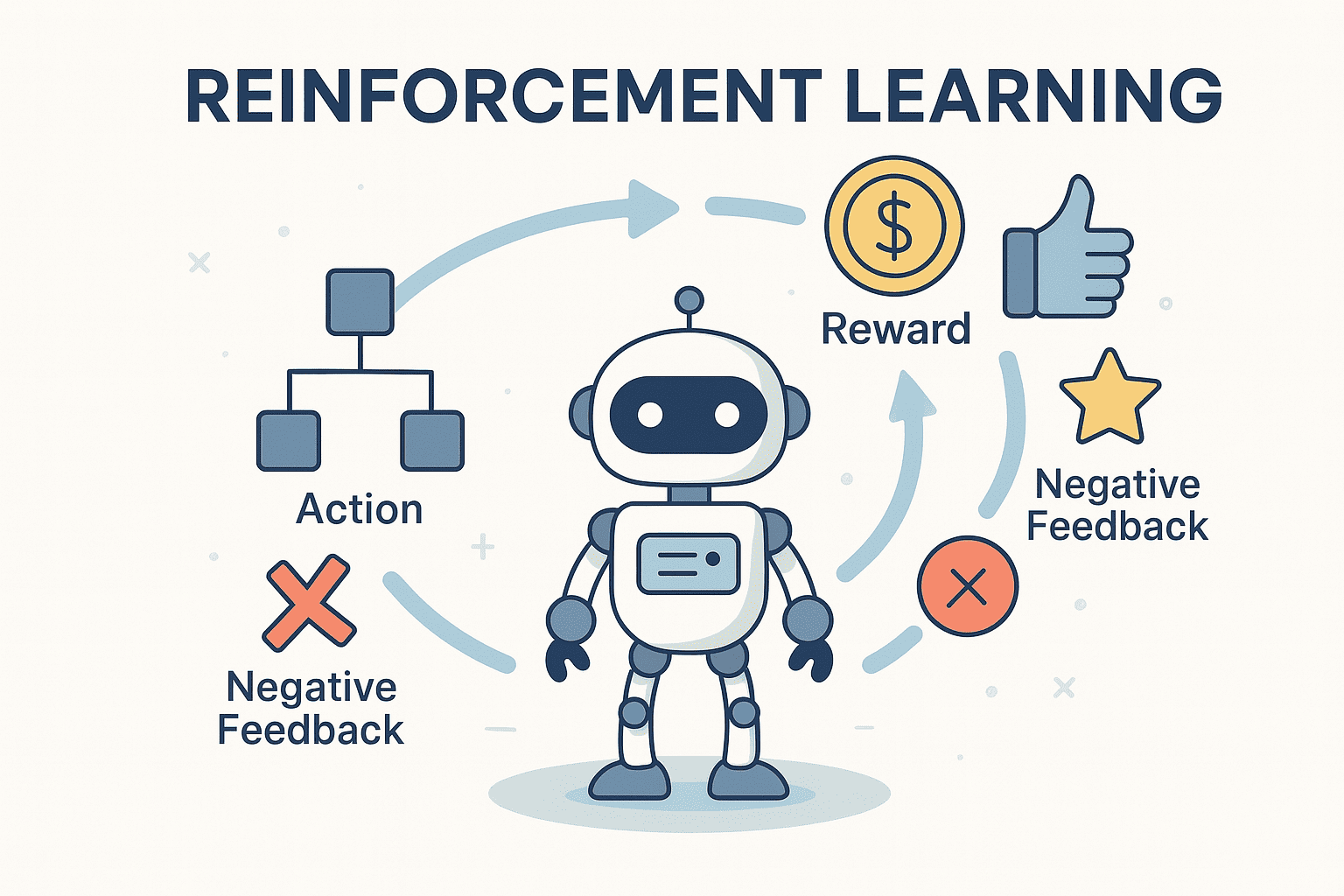Reinforcement Learning
Reinforcement Learning
Reinforcement Learning lets an AI master a skill through pure trial and error, getting rewarded for good moves without needing hand-fed data. We’ll break down the core process, its biggest benefits, the different approaches, and how to pick the right one for your project.
What Is Reinforcement Learning?
Reinforcement Learning (RL) is an ML (machine learning) technique where an agent learns how to make optimal decisions through direct interaction with its environment. Instead of relying on pre-labeled data like supervised learning, an RL agent explores, acts, and learns from the consequences to maximize a cumulative reward over time. It’s all about making choices that lead to the most favorable outcomes.

How Does Reinforcement Learning Work?
Reinforcement Learning operates through a trial-and-error process. The agent perceives the environment, takes actions, and learns through a feedback loop of rewards and penalties. The principal goal is to develop a strategy, called a policy, that maximizes cumulative rewards. Through experience, the agent discovers how to refine its decisions over time.
Key Features
- Agent and Environment: The agent takes actions within the environment and adjusts based on feedback.
- Rewards and Penalties: The agent receives feedback in the form of rewards or penalties that guide learning.
- Exploration vs. Exploitation: The agent must balance exploring new actions and exploiting known strategies that lead to higher rewards.
- Policy: A policy is the strategy the agent follows to decide its actions based on the state of the environment.
Benefits
- Autonomous Learning: RL allows agents to learn autonomously, i.e., without needing human intervention or labeled data.
- Adaptability: The model can adapt to dynamic environments, making it ideal for real-world applications where conditions constantly change.
- Optimal Decision Making: RL models can discover optimal strategies that might be difficult for humans to design.
Use Cases
- Robotics: From assembly and navigation to interacting with people, robots are using RL to learn a wide variety of tasks.
- Gaming: RL excels at navigating the complex decision-making required in games, producing landmark achievements like AlphaGo and the OpenAI Five bot for Dota 2.
- Finance: RL helps optimize investment strategies in algorithmic trading, based on market conditions.
- Healthcare: RL has applications in personalized treatment plans, optimizing drug dosages, and managing patient care in dynamic environments.
Types of Reinforcement Learning
Reinforcement Learning is not a single method but a field with distinct approaches. Each of these approaches is defined primarily by how an agent learns from feedback and makes decisions.
Model-Free Reinforcement Learning
Model-free RL operates on pure trial and error. The agent learns what works by directly interacting with the environment and collecting rewards, without trying to understand the ‘why’ behind it. Over time, this accumulated experience is all that’s needed to build a successful decision-making strategy.
Model-Based Reinforcement Learning
Model-based RL includes first building a model of the environment. The agent uses this internal model to plan and simulate the potential outcomes of its actions. By “thinking” about the consequences before acting, this approach can be more data-efficient and adapt faster to changes.
Deep Reinforcement Learning (Deep RL)
Deep RL supercharges these methods by combining them with deep learning. It uses powerful neural networks to approximate policies and value functions, allowing agents to operate in highly complex environments with vast numbers of states, like mastering video games or controlling robotic arms. Deep RL can be either model-free or model-based.
Multi-Agent Reinforcement Learning (MARL)
This approach scales RL to scenarios with multiple agents interacting within the same environment: Each agent learns while considering the actions of others. That makes MARL essential for tasks that require either coordination or competition, such as managing drone swarms, playing team-based games, or modeling economic markets.
Choosing the Right Reinforcement Learning
Choose your RL method based on the problem you’re solving, the complexity of the environment, and the resources you have.
As general guidelines:
- The direct, trial-and-error learning of Model-Free RL is often sufficient for straightforward tasks.
- On the other hand, the planning capabilities of Model-Based RL or the pattern-recognition power of Deep RL are far more suitable in complex scenarios where understanding the environment’s dynamics offers a key strategic advantage.
- Multi-Agent RL is the right framework for navigating cooperation and competition if the task is inherently social, involving multiple actors.
Your final choice should be guided by a careful consideration of the trade-offs between learning speed, computational demand, and the timeless RL challenge of balancing exploration with exploitation.